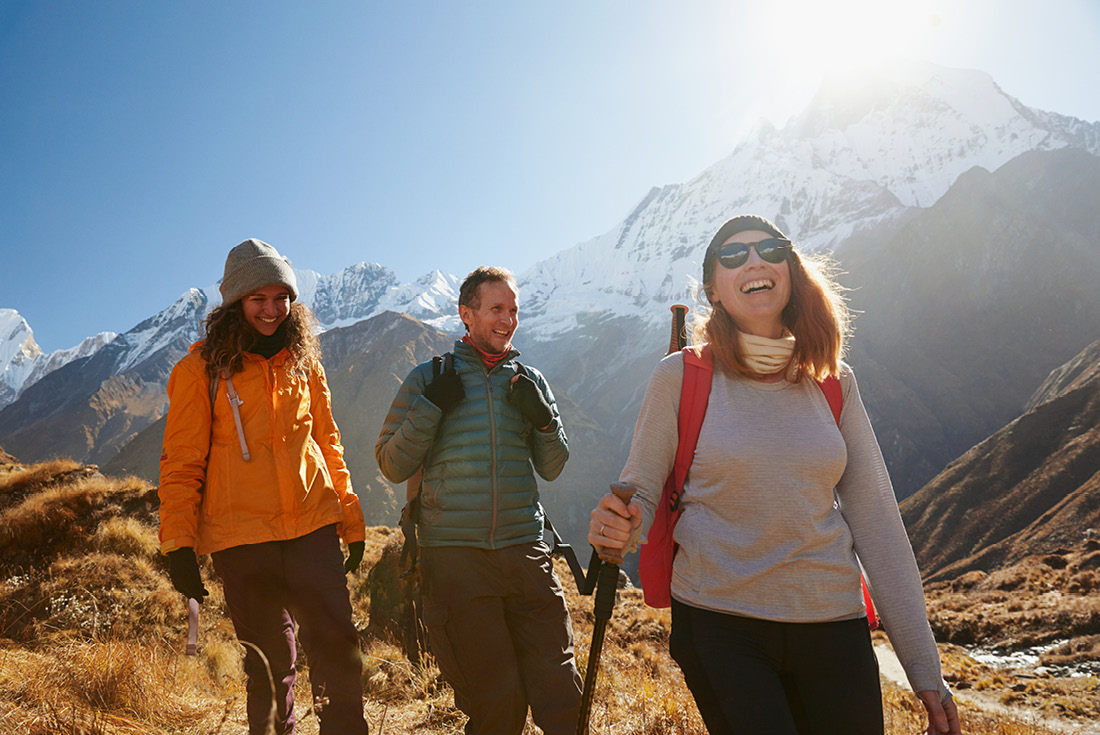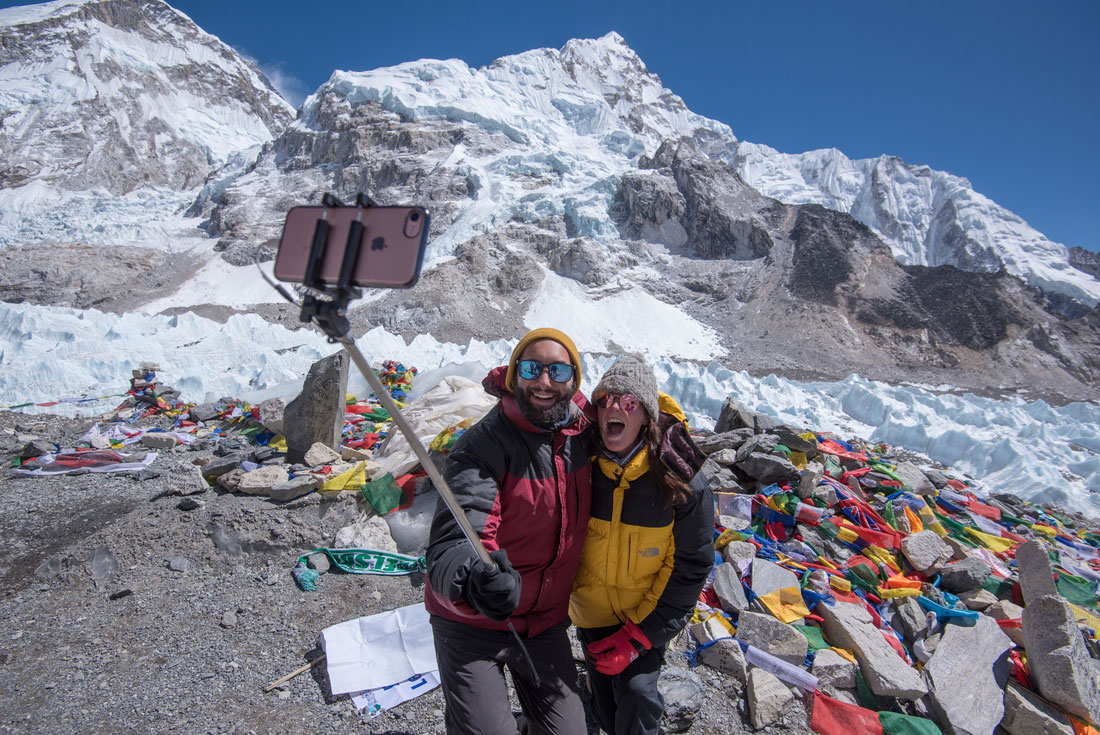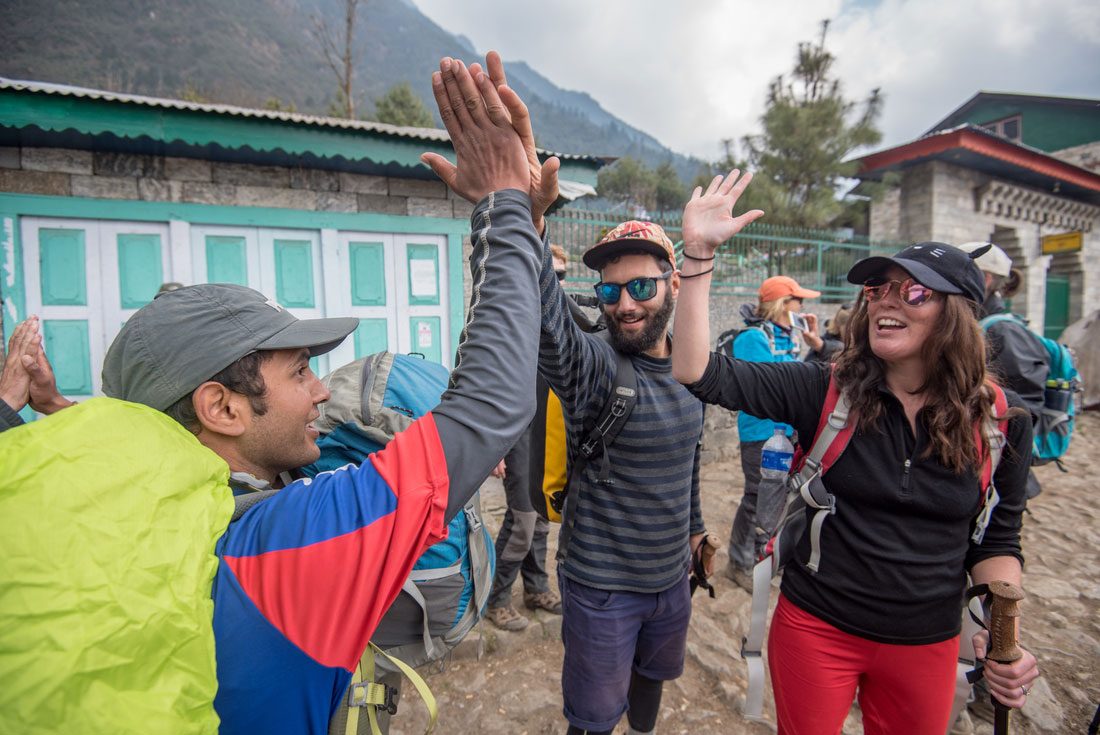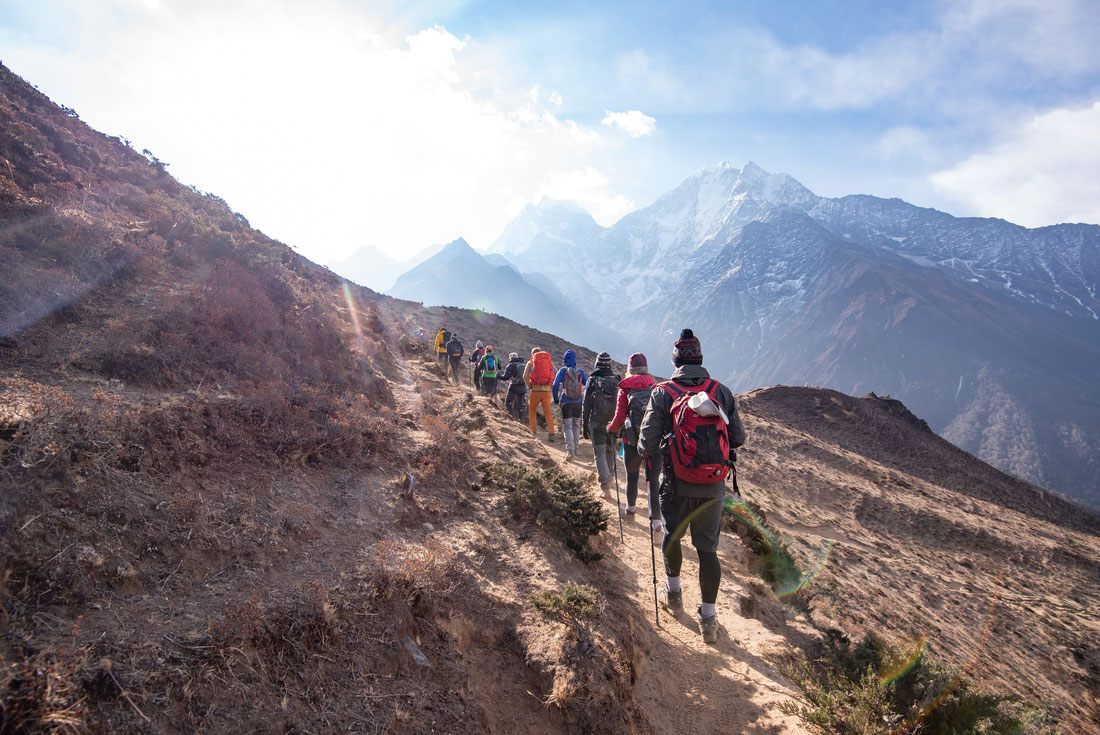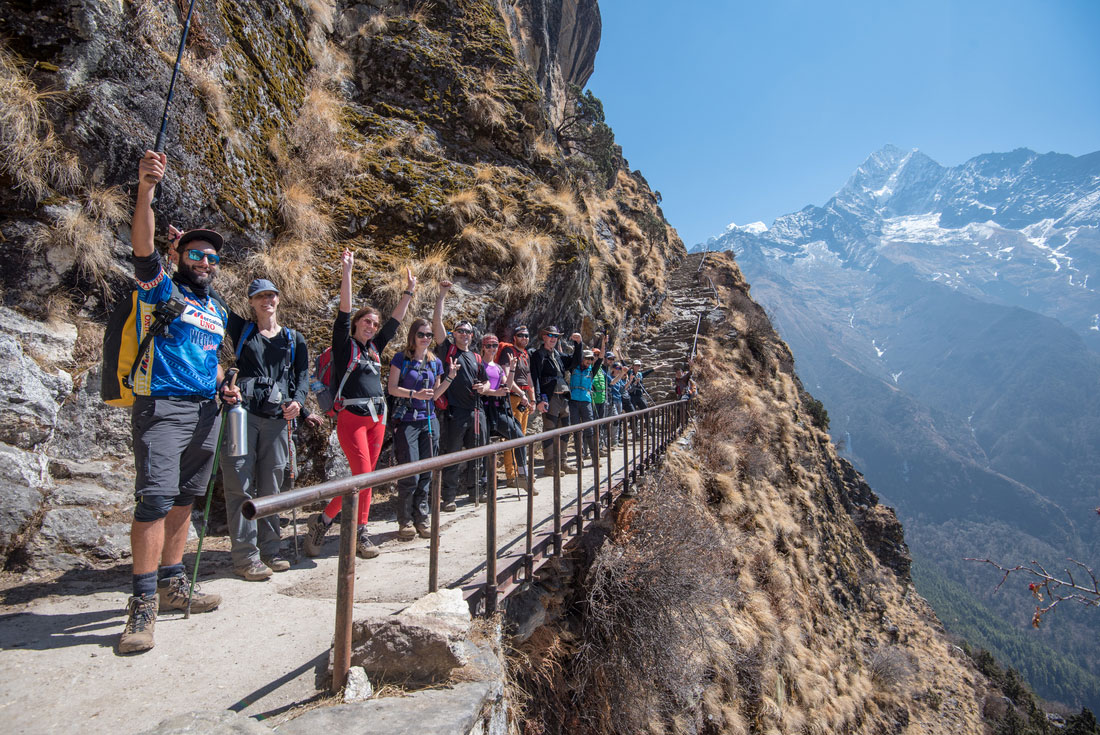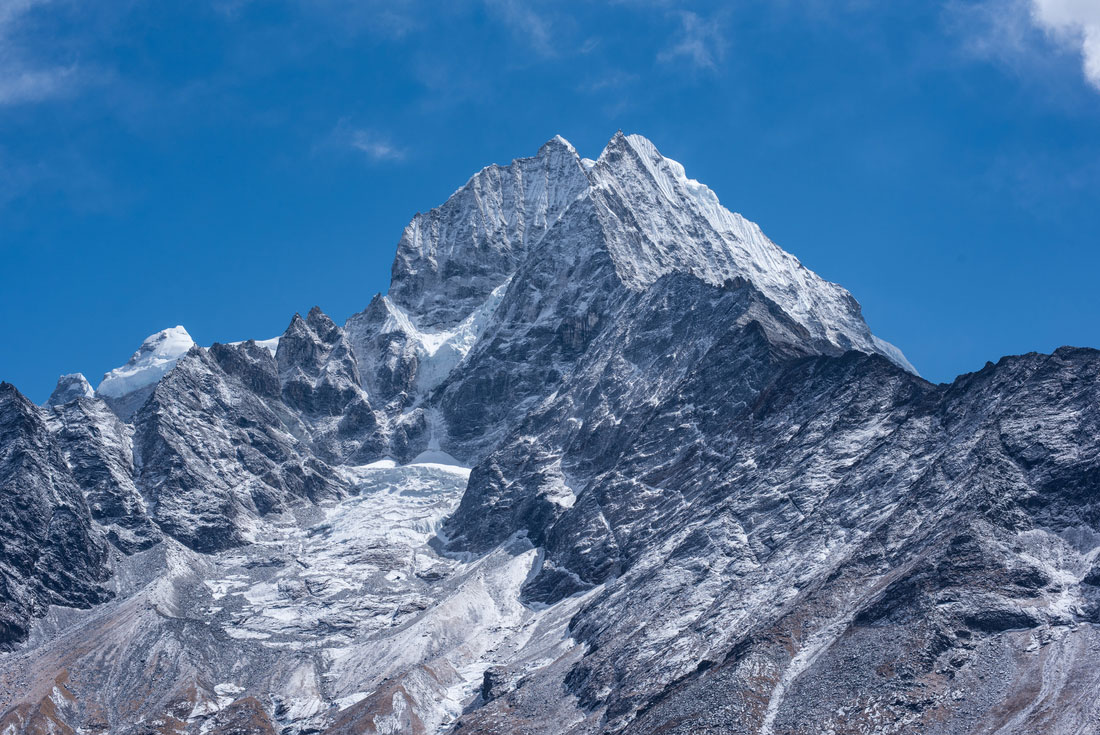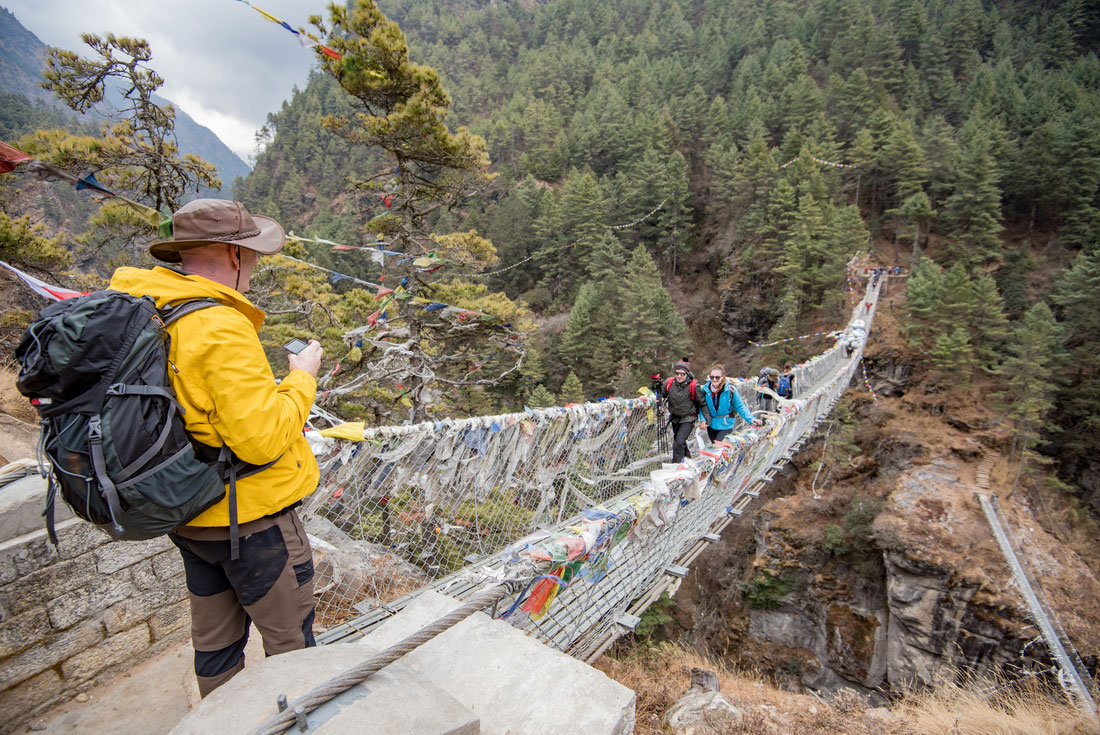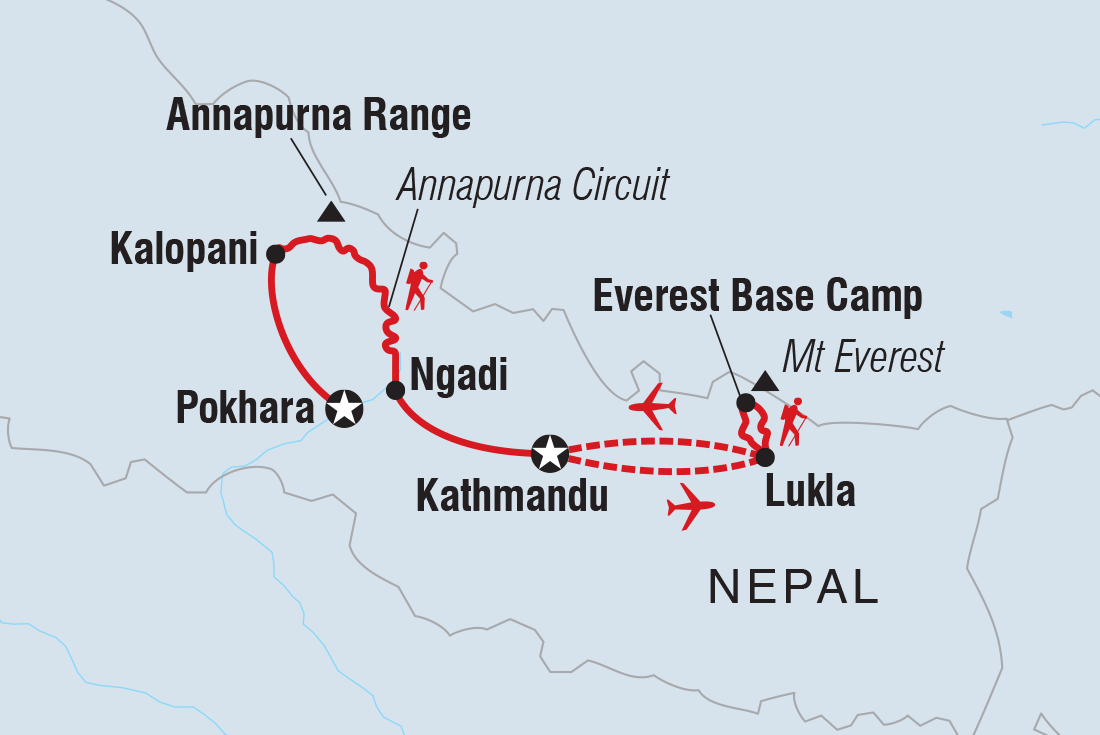SUMMARY
Experience Nepal’s major mountains on this challenging 30-day trekking adventure. Conquer Everest Base Camp, a holy grail for mountaineers, and tick the iconic Annapurna Circuit off your hiking wish list. Take in the stunning scenery and soak up the rich Sherpa culture and traditions of this beautiful country, exploring tiny villages and meeting friendly locals along the way. If you’ve ever dreamed of seeing the wind-swept peak of Everest, traversing high passes and crossing blue-white glaciers, this trip is the one for you. ALTERNATE ITINERARY: In case of weather conditions leading to cancellations or delays of included flights, this trip will operate on an alternate itinerary. Please see Day 1 of the itinerary for more details.
TOTAL DURATION : 30 Days
GROUP SIZE : MIN 1 MAX 16
TOUR ITINERARY AND DATES
START : Kathmandu
END : Pokhara
COUNTRIES VISITED : Nepal
Validity : 01 JAN 2025 To 31 DEC 2025
Day :1
Location : Kathmandu
Namaste! Welcome to Kathmandu, the colourful capital of Nepal where ornately carved balconies mingle with beautiful shrines and temples. Your adventure begins with a welcome meeting at 2 pm today. If you arrive with time to spare, maybe check out the storied stupas and pagodas of Swayambhunath (Monkey Temple) or take a walk around the local Durbar Square. If you’ve got limited time in the city, you might also like to consider an Urban Adventure. ALTERNATIVE ITINERARY DUE TO FLIGHT CANCELLATIONS: Weather conditions in the Himalayas can change rapidly, which can result in the need for changes to be made to our intended itineraries. Flights throughout Nepal – particularly in high mountain areas – are often delayed or cancelled due to poor weather conditions. Flights between Kathmandu/Ramechhap and Lukla are particularly prone to these delays which has the potential to vary the itinerary of our tour departures. Our contingency plans in case of bad weather preventing the fixed wing aircraft flight from Kathmandu/Ramechhap to Lukla are as follows: Day 2 – We will attempt to board our booked fixed-wing plane as per the itinerary. If this flight is cancelled, we will return to our hotel in Kathmandu/Ramechhap for an additional night. Day 3 – We will again attempt to board our booked fixed-wing plane. If this flight is cancelled we will endeavour to charter a helicopter to transport the group, provided helicopters are available and weather does not prevent them from flying to Lukla. There may be delays for helicopter flights due to limited availability of safety audited helicopter operators. Travellers will need to use their emergency fund to cover the cost of the chartered helicopter. The exact cost will depend on how many travellers are in your group and could be up to US 500 per person. It is common practice for the helicopter company to charge varying prices, so you may pay different amounts to others on the flight. If we reach Lukla on day 3 by either fixed wing aircraft or helicopter we will then follow the same itinerary to Everest Base Camp but descend over one less day in order to take our return flight from Lukla on day 14. Day 4 – If both fixed-wing planes and helicopters are unable to reach Lukla on the morning of day 3, then on day 4 we will drive back to Kathmandu by private vehicle. While we will not be able to reach Base Camp itself on the altered itinerary to Langtang - Gosainkunda Trek, our travellers have still found it a highly enjoyable trek with superb views of snow caped mountains and visit the beautiful lake - Gosainkunda. This lake is sacred for both Hindu and Buddhist pilgrims. We also advise allowing a few extra days in Kathmandu at the end of your trip should your return flights from Lukla be delayed due to weather conditions.
Day :2
Location : Phakding (2610 m/8563 ft)
Today we have a very early flight from Kathmandu to Lukla. If the weather is good, the views of the Himalayas from the small plane are amazing! After breakfast in Lukla (2840 m), a short safety talk and an introduction to your porters, gear up and commence your trek. Today is a fairly gentle introduction, following the milk-white Dudh Kosi River approximately three-hours to Phakding (2610 m).
Day :3
Location : Namche Bazaar (3440 m/11,286 ft)
Today you’ll trek to Namche Bazaar, where you’ll spend two nights acclimatising to the altitude – and might even get your first look at Everest itself. From Phakding, you’ll begin to head up the valley. The trail, lined with blue pine forest, follows the river valley and is especially spectacular in spring when the rhododendron flowers are bright in bloom. Cross the Dudh Kosi river at Benkar, and look way up above 6,000 metres to see the peaks of snow-capped Kusum Kanguru (6369 m) and Thamserku (6623m). Press on to Monjo (2835m), a good place to break for lunch. From here the walk starts to get a little tougher, with a steep ascent to Namche Bazaar. Enter into the national park, cross the river through the village of Jorsale (2805m) and then continue upstream. Cross the spectacular Hillary Bridge and begin the ascent to Namche Bazaar. Get your camera out as on a clear day you’ll get your first glimpse of the peaks of Everest, Lhotse, Nuptse and Taweche. Namche will be your last chance to check your equipment and hire any additional gear for the high altitudes from Dingboche onwards.
Day :4
Location : Namche Bazaar (3440 m/11,286 ft)
You’ll stay at Namche Bazaar for another night so that you can properly acclimatise to the altitude. One of the best ways to do this is to take a strenuous walk up to a high altitude then come back down to sleep. Your optional (but recommended) walk today will take you to see views from the Tenzing Norgay Memorial and Sagarmatha National Park Museum above the village. If the conditions are right, this stunning vista includes a panorama of the Khumbu peaks and great views of Everest. The national park museum is also home to interesting displays about Sherpa lifestyle and culture, and the local flora and fauna. Then, continue your hike to higher elevations with a visit to Sagarmatha Next, who support local communities to create and implement a sustainable waste handling system in the region. Return to town and enjoy a free rest of your day. Namche gained its importance during the period when Tibetan salt was traded for the lowland grains of Nepal. There's still a roaring trade in the village centre, so be sure to use this chance to stock up on any extra supplies you might need.
Day :5
Location : Phortse Gaon (3810 m/12,500 ft)
Not many groups stop in Phortse – a traditional Sherpa village that offers an insight into their life and culture – so today will be something special. Leave Namche and weave your way above the valley, then take the less-travelled fork in the road just after Sanasa. Most travellers follow the same path to and from Base Camp, while you’ll make more of a loop to see more of the national park. Climb for some epic views of the valley below, and then stop for a mini acclimatisation lunch at around 4000 m. After lunch, make your way downhill to cross the Dudh Koshi again, then make a final uphill push to your teahouse in Phortse. The dramatic mountain views, peace and quiet of this village make this one of the highlights of the trek. Here you’ll be almost completely above the treeline, so the sunsets make for perfect pictures.
Day :6
Location : Dingboche (4410 m/14,469 ft)
Enjoy the stillness of Phortse at sunrise, and then set off along the trail taking in the incredible views of Kangtega, Ama Dablam (6812 m) and – if the skies are clear – Mt Everest. Perhaps stop for a tea in Pangboche, and after lunch in Shomare you’ll notice the scenery around you start to change, with forests being replaces with rocky outcrops. Once you arrive in Dingboche, you’ll find a beautiful patchwork of small fields enclosed by stone walls. The scenery is once again spectacular and although Everest will be hidden behind the Lhotse-Nuptse Ridge, the huge peaks that tower above the eastern end of the valley are more than worthy. If the weather’s right, then there will be gorgeous sunsets illuminating the peaks – Ama Dablam, the south face of Lhotse to the north and Island Peak in the centre of the valley.
Day :7
Location : Dingboche (4410 m/14,469 ft)
Today is another acclimatisation day. You'll take morning hikes to Nagarjun Hill or Chukkhung, returning to Dingboche for lunch. Then, take some time to in the afternoon to explore the town or rest up at your teahouse.
Day :8
Location : Lobuche (4910 m/16,109 ft)
From Dingboche, ascend the small ridge behind the village above the Pheriche valley. From the stupa at the top, Taweche and Cholatse (6440 m) make for a pretty striking scene – they seem to lean forwards from across the valley in the west. To the north, Lobuje Peak (6119 m) and the snowfields of the Cho La are the kings of the skyline. The walking will now be fairly flat on wide-open fields, but remember that there’s no rush – take your time and ensure you’re well hydrated. Late in the morning you will cross the Khumbu Khola at Dughla and take a light lunch at the foot of the huge terminal moraines of the Khumbu Glacier flowing off Everest. In the afternoon, there will be a solid and quite steep climb on a rocky trail to the top of the moraines. On the crest of the ridge, you’ll pass a line of memorial cairns (stacks of stones), built in memory of the Sherpas and climbers who have died on various Everest expeditions over the last fifty or so years. From here the view is downright spectacular once again, with Pumori (7145 m), Lingtren (6697 m), Khumbutse (6623 m), and across the border in Tibet, Changtse (7550 m), surrounding you. Then follow the valley stream to the lodge at Lobuche, arriving early afternoon.
Day :9
Location : Gorak Shep/Everest Base Camp (5140 m/16,864 ft)
This is the big one, the day of Everest Base Camp. From Lobuche, follow the broad valley that runs parallel to Khumbu Glacier, with a gradual ascent enabling you to build the slow, steady rhythm required when walking at high altitude. When you reach the moraines of Changri Nup Glacier, you will make a series of small ascents and descents over a rocky trail lined with cairns that eventually leads to the surprising glacial sands of Gorak Shep (5160 m) – reached after about three hours of walking. Now’s the time to grab a quick bite, gear up appropriately and then head off towards Everest Base Camp. The trek can be achieved in around three hours, and if trekking in the popular climbing period of March to May, you’ll almost certainly encounter yaks and porters supplying food and equipment to expeditions here. From Everest Base Camp you won’t get views of Mount Everest, but you are able to see glorious glaciers, lakes, caves and the notorious Everest Ice Fall that flows from the Western Cwm. The return journey from the Base Camp to Gorak Shep takes the same amount of time. You’ll have an early dinner so that you are able to get up early the next day for awe-inspiring views of the Himalayan giants from Kala Patar.
Day :10
Location : Kala Pattar/Pheriche (4240 m/13,191 ft)
Today you’ll see some of the Himalayas’ most recognisable sights. Make an early start to avoid the early morning clouds and trek to Kala Pattar (5545 m) to witness the best views of Everest. The ascent is quite steep and made more difficult because of the altitude, so start very slowly and try to ascend at a steady rhythmic pace. Kala Patar is the rocky hilltop below Pumori, and Nuptse, Changtse, Ama Dablam, Taweche, Kantega and Everest – they’re all here. About three kilometres away and some 200 metres below, the area of the Everest Base Camp can be seen in a bowl at the bottom of the Khumbu Ice Fall. Spend as long as you like to savour an extra special moment, then it’s all downhill from here – the descent to Gorak Shep is easy and when you arrive back at the lodge you’ll have a quick drink and head off to the rooms to pack your kit bags while breakfast is being prepared. After breakfast set off to Lobuche and Thugla, where you’ll stop for lunch. Then cross the Khumbu Khola and head down the valley below Cholatse to Pheriche, where you’ll stop for the night.
Day :11
Location : Tengboche (3860 m/12,664 ft)
Descend through the small settlements at Orsho and Shomare before passing through Lower Pangboche. Here you’ll reach the suspension bridge over the Imja Khola River, then ascend to Tengboche to visit the monastery. According to legend, Lama Sange Dorjee, who came from Tibet’s Rongphu Monastery, founded Thyangboche Monastery in the 17th century. Tengboche was destroyed by an earthquake in 1933, rebuilt and again badly damaged by a fire in 1989. Construction of the present monastery was completed in 1992. Spend a bit of time visiting the monastery and the Sherpa Heritage Foundation museum before settling in for the night at your teahouse.
Day :12
Location : Chumo (2860 m/9383 ft)
Descend steeply along switchbacks through beautiful forest of juniper, rhododendron and fir. Cross the Dudh Kosi River and follow the trail up to Trashinga. From here the path contours high above the valley through Shanasa and on to Namche Bazaar, where you’ll stop for lunch. Then descend steeply down back to the Hillary Bridge and cross the Dudh Kosi River. You’ll follow the trail through Jorsale and back to Chumo, where you’ll stop for the night.
Day :13
Location : Lukla (2840 m/9318 ft)
You’ve done it, your last day of trekking! Today you'll walk back to Lukla via Benkar through blue pine and rhododendron forest, with great views of Kusum Kangaru. From here, make the final climb up to Lukla, where you’ll say goodbye to your crew. Celebrate with a hot shower and a few drinks with your group before flying back to Kathmandu tomorrow morning.
Day :14
Location : Kathmandu
Weather permitting, you'll take a short early morning flight from Lukla to Kathmandu. Return to your accommodation and have free time during the afternoon for further sightseeing or shopping. You could visit one of Kathmandu's many markets for clothing, embroidery, carpets or ceramics. If shopping is not your thing, take a trip over the Bagmati River to the adjacent city of Patan, with its abundance of temples and monasteries. Enjoy the night together, reliving the first of your epic treks!
Day :15
Location : Kathmandu
Today is a free day in Kathmandu, so feel free to lie in if your body needs it before your next hike. If you’ve got a little more energy, maybe visit the nearby city of Patan, full of ancient temples and palaces to explore. Perhaps go for dinner tonight and try momos, the Nepalese dumpling dish that has made a name for itself beyond the region.
Day :16
Location : Kathmandu
You'll meet your new group for a welcome meeting at 2 pm today. Before then, feel free to continue exploring the network of street markets and alley bazaars. If you haven’t already visited Pashupatinath Temple, it’s definitely worth checking out before you leave Kathmandu tomorrow. The Hindu temple – and UNESCO World Heritage site – is the oldest one in Kathmandu, with a recorded existence as early as 400 AD.
Day :17
Location : Ngadi (930 m/3051 ft)
Start your Annapurna Circuit Trek with a morning drive from Kathmandu to Ngadi. During the journey, you'll see stunning views of the Trishuli River, green hills, terraced fields and the Himalayas. Following the Marshyangdi River, you’ll pass through charming towns and Besisahar, the gateway to the Annapurna Circuit Trek. Arrive in Ngadi by late afternoon, check into your guesthouse and relax as you prepare for your trek.
Day :18
Location : Chamje (1430 m/4692 ft)
Keep an eye out for dazzling cascades along your trail today as it makes its way through a deep wooded canyon with a few stretches of steep climbing. Wander through rice paddies, follow winding trails through sub-tropical forest, cross suspension bridges swaying over raging rivers, pass waterfalls of melted snow and climb steep mountain passes. Over the next ten days you’ll come across isolated mountain communities, each with different ancestral customs and traditions. Be prepared to be inspired, mesmerised, challenged and delighted.
Day :19
Location : Dharapani (1860 m/6102 ft)
Today’s trek continues through the deep wooded canyon embellished by stunning waterfalls. You’ll be venturing into the Manang district of the mountain range, with much of the trail ascending throughout the day.
Day :20
Location : Chame (2670 m/8760 ft)
Marking the end of the great Marsyangdi Gorge, make a steep climb to Timang, then the trail settles into gentler slopes as the vegetation transforms from dense pine forests to drier slopes. The district headquarters of Manang, Chame, is the largest settlement after Besisahar.
Day :21
Location : Pisang (3200 m/10,499 ft)
A slew of breathtaking scenery is on the cards today as the trail goes through a deep gorge then past the great sweeping slope of Paungi Danda. On the way to Chame stop at a beautiful apple orchid for a tea break. Today is mostly an easy walk with a few ascending stretches of trail dotted throughout the day.
Day :22
Location : Manang (3540 m/11,614 ft)
Trek the northern trail via upper Pisang and Ghyaru – an area renowned for its spectacular views.You're sure to come across local farmers herding yaks. Here’s a hot tip – Tibetan yaks take a special interest in people wearing red, so choose your gear carefully today!
Day :23
Location : Manang (3540 m/11,614 ft)
Spend a day here to acclimatise by trekking to a higher altitude, then returning to the lower altitude of Manang for the night. Manang, a village of about 500 flat-roofed houses, offers excellent views of Annapurna II, Annapurna III, Gangapurna and Chulu East.
Day :24
Location : Yak Kharka (4050 m/13,287 ft)
Today will be a steadily uphill climb into the alpine region of the mountain range. You’ll arrive at Yak Kharka, ready for an easier day of trekking tomorrow to acclimatise to the high altitude.
Day :25
Location : Phedi (4525 m/14,846 ft)
Due to the altitude, feel free to take the next section of the climb at a leisurely pace, meaning you’ll have time to admire the magnificent views from this part of the route. Once at Phedi, there’ll be plenty of time to rest and acclimatise to the higher elevations ready for the next part of the climb, where you’ll encounter the Thorung La Pass – the highest point on this Annapurna Circuit.
Day :26
Location : Muktinath (3800 m/12,467 ft)
Setting off very early to cross the Thorung La Pass (5416 m), the trail is steep but easy to follow. After a climbing trek, reach the Pass's peak, adorned with prayer flags, a traditional stupa (chorten) and stone cairns built by travellers. Stop to admire the stunning views and marvel at how far you've climbed. Further along, the trail descends steeply proceeding towards Chabarbu. From here on, the trail crosses meadows, drops into a deep ravine, climbs out and follows a wide trail into Muktinath – a pilgrimage site held in great reverence by both Hindu and Buddhist populations.
Day :27
Location : Kalopani (2526 m/8287 ft)
Veer off the main trekking trail to make a side trip to an ancient village of Purang. Further up from the village, continue to take the less frequented route going past another village with a medieval feel to it – Jhong. From Jhong, descend to the Jhing Khola (river), following the course which you emerge on to Kagbeni. After lunch, visit the village of Marpha, known for its natural beauty, culture and heritage. Wander around the village and explore beautifully designed buildings and perhaps try some locally produced apple jam. After, drive to Kalopani. Admire stunning views of the Dhaulagiri and Annapurna Mountain ranges including Annapurna 1, and relax while taking in the panoramic Himalayan vistas.
Day :28
Location : Pokhara
After breakfast, depart from Kalopani by 4WD enjoying a scenic journey through Nepal’s diverse landscapes. As you travel, take in the lush greenery of the terraced fields, charming rural villages, and the winding roads alongside the Seti River. The route offers occasional glimpses of the majestic Himalayas in the distance. Arrive in Pokhara by the afternoon.
Day :29
Location : Pokhara
Enjoy a free day in Pokhara to unwind, relax and give those muscles a rest after all that trekking. Your leader can advise you of sightseeing opportunities. It is worth taking a boat for a row out on the lake, especially if the weather's fine. The lakeside area has great shopping and cafes. Pokhara has an interesting old area as well as an elaborate Hindu temple and a Buddhist monastery. Perhaps visit the Peace Pagoda, where spectacular views of the mountains await. You can see the Annapurnas from here, and the famous fishtail peak, Machhapuchhare, and back across to Pokhara. You can also visit the fascinating International Mountain Museum to learn some amazing tales of past climbing expeditions.
Day :30
Location : Pokhara
With no activities planned for today, you are free to leave at any time. Pokhara is a stunning and peaceful lakeside haven, so if you would like to spend more time here, we’ll be happy to organise additional accommodation (subject to availability).
Reference : IT

